|
|
Created/dedicated as per personal communication with Timothy Sakhuja, August 18, 2010.
Updated as per James P. Tuttle's The Hawk Moths of North America, August 18, 2010.
Updated as per Butterflies and Moths of North America, formerly USGS, August 18, 2010
Updated as per personal communication with Ken Salvo, Eumorpha achemon, May 28, 2018, Roseville) May 28, 2018
|
Placer County, California
Sphingidae
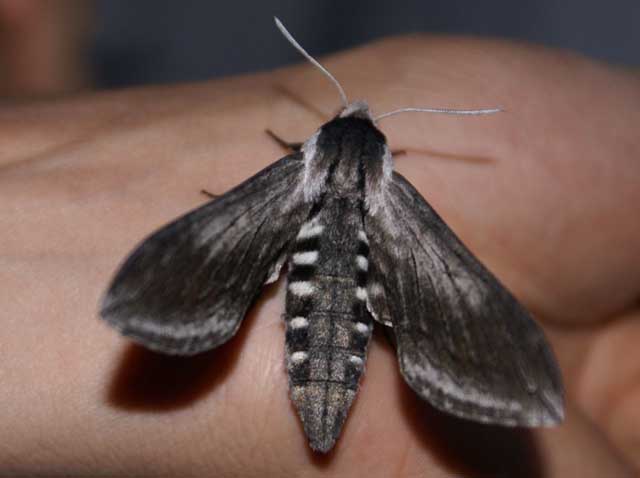
Sphinx perelegans Kings Beach, Placer County, California,
taken at UV light, July 6, 2010, courtesy of Timothy Sakhuja.
This page is dedicated to Timothy Sakhuja who sent me images of Sphinx perelegans and Sphinx vashti, taken at UV collecting
light in Kings Beach [Lake Tahoe], California (Placer County) in the Sierra Nevada Mountains at 10.40 pm. on July 6, 2010.
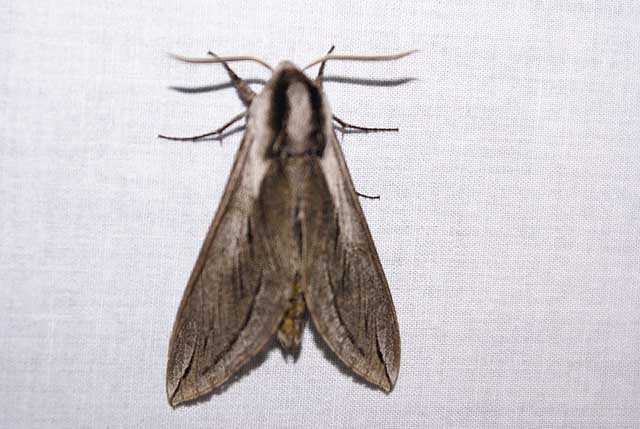
Sphinx vashti Kings Beach, Placer County, California,
taken at UV light, July 6, 2010, courtesy of Timothy Sakhuja.
Thirty-two Sphingidae species are listed in the USGS for California. Not all of the species are reported by the USGS for
Placer County. (Nine species are listed by the USGS for Placer County as of August 18, 2010).
It is hoped that this checklist, with the thumbnails and notes, will help you quickly identify the moths you have encountered.
A WO" after the species name indicates that I have no confirmed reports of this species in Placer County, but I
(William Oehlke) expect that this moth is present.
A USGS indicates the moth is reported on the USGS website and/or in Moths of Western
North America, #2. Distribution of Sphingidae of Western North America, revised, an excellent little booklet available through Paul Opler.
Please help me develop this list with improved, documented accuracy by sending sightings (species, date, location), preferably with an
image, via email to Bill Oehlke.
Many thanks also to Jeff and Hillary Pierson of Roseville who provide the following image of a Manduca sexta larva.
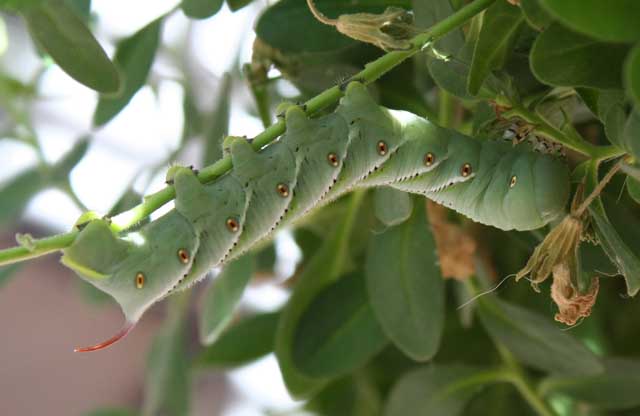
Manduca sexta fifth instar, Roseville, Placer County, California,
September 7, 2012, courtesy of Jeff and Hillary Pierson.
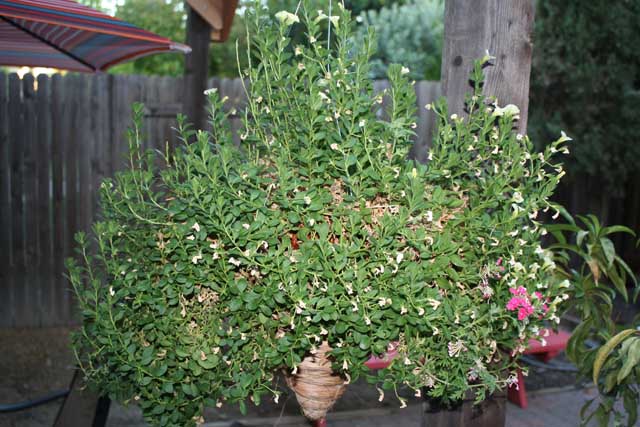
Manduca sexta larva host, Roseville, Placer County, California,
September 7, 2012, courtesy of Jeff and Hillary Pierson.
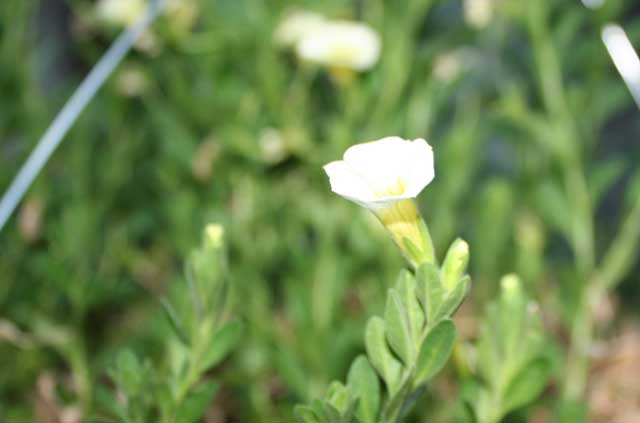
Manduca sexta larva host, Roseville, Placer County, California,
September 7, 2012, courtesy of Jeff and Hillary Pierson.
James P. Tuttle's The Hawk Moths of North America is an excellent reference. His distribution map for Manduca sexta for California
shows western Placer County as the edge of the northeastern distribution for Manduca sexta in California. I wondered if possibly an egg of an immature larva
had been imported on the store purchased host, but Jeff indicates the potted plant was purchased at Home Depot in May, around Mother's Day, and the larval image was taken in
early September, September 7, 2012. Our conclusion is that the egg was deposited in Placer County, probably some time in late July or in very early August.
Roseville is near the center of Placer County, probably slightly east of the range indicated on James P. Tuttle's distribution map.
I believe the host plant is a Petunia species in the Solanceae family.
Many thanks to Ken Salvo who provides the following image from Roseville.
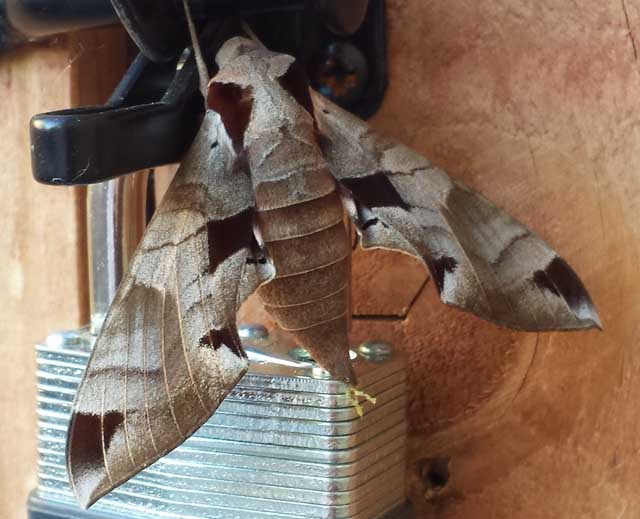
Eumorpha achemon, Roseville, Placer County, California,
May 28, 2018, courtesy of Ken Salvo, id by Bill Oehlke.
Visit Placer County Sphingidae Larvae: Hawkmoth Caterpillars
Visit North American Catocala: Underwing Moths
Visit National Sphingidae Pictoral Checklists: All Countries in North, Central and South America
Sphinginae subfamily
Sphingini tribe:
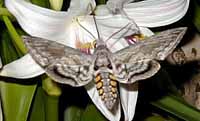 |
This large bodied moth flies in tobacco fields and vegetable gardens
(potatoes, tomatoes) and wherever host plants are found. |
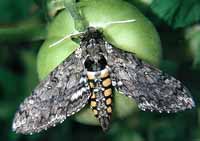 |
Manduca sexta
J&HP, the Carolina Sphinx:
Abdomen usually has six pairs of yellow bands, broken across the back. Sixth set quite small.
Fw upperside has indistinct black, brown, and white markings.
Hw upperside banded with black and white, with two black zigzag median lines that are very close together with hardly any white between them.
Fw fringes spotted with white.
|
Manduca sexta larva, Roseville, September 7, 2012, Jeff and Hillary Pierson.
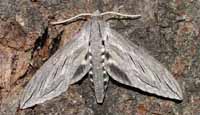 |
Sphinx chersis
WO, the Northern Ash
Sphinx or Great Ash Sphinx
The upperside of the forewing is soft dark-gray to blue-gray with
a series of black dashes, one reaching the wing tip. Note grey
thorax with narrow black lines.
|
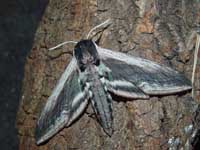 |
Forewings, long and slender, are held close to the body when the moth
is at rest.
I only see them occasionally on P.E.I. despite visiting lights
frequently. |
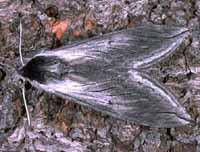 |
Sphinx perelegans adults fly in montane woodlands and mixed chaparral-type vegetation as a single brood
in the north, with adults mainly on the wing in June and July.
It flies from dusk until after midnight. Note dark thorax. |
Sphinx perelegans, Kings Beach, July 6, 2010, courtesy of Timothy Sakhuja.
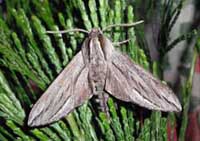 |
Adults fly as a single brood in the desert and in pinyon-juniper
woodland from May to August. generally more westerly |
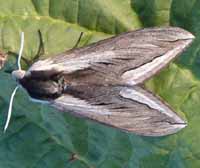 |
Sphinx vashti
USGS/TS, the Snowberry Sphinx
The upperside of the forewing has a narrow black subterminal line
bordered by a white inverted V-shaped line on the outside, and a
black line running inwards from the apex of the wing.
It is most often found in montane woodlands and along streamcourses.
|
Sphinx vashti, Kings Beach, July 6, 2010, courtesy of Timothy Sakhuja.
Smerinthini Tribe:
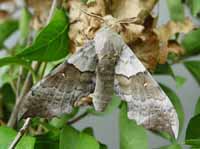 |
This one is quite similar to Pachysphinx modesta, with modesta
being smaller and darker.
Moths should be on the wing from June-August.
|
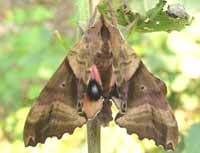 |
The grey-blue eyespot (without a black center pupil) of the hindwing gives this species its name.
Larvae feed on birches, willows, cherries and oaks.
The outer edge of the forewings is quite scalloped. |
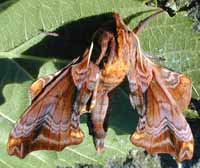 |
This small species might be present. This species ranges across North
America.
The hindwings have a small blue eyespot ringed with black on a yellow
background.
|
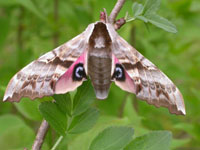 |
Smerinthus cerisyi
USGS, the Cerisyi's
Sphinx or One-eyed Sphinx, Larvae feed on poplars and willows.
Flight would be from late May-July as a single brood.
|
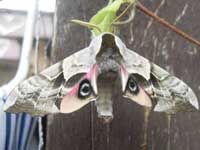 |
Smerinthus opthalmica.
Larvae feed on poplars, aspen and willows.
Note different shape of double arced forewing pm line compared to the straighter pm line of cerisyi, directly above.
S. ophthalmica has smoother scalloping of the fw outer margin. Ophthalmica can be grey or brown. |
Macroglossinae subfamily
Dilophonotini Tribe:
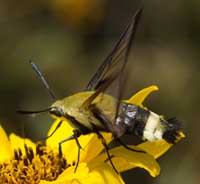 |
Hemaris thetis USGS, the Thetis Clearwing or Bee Hawk Moth,
The moth flies along forest edges and in meadows, gardens and
brushy fields. Day-flying adults nectar at lantana, dwarf bush honeysuckle,
snowberry, orange hawkweed, thistles, lilac, Canada violet, etc.
|
Philampelini Tribe:
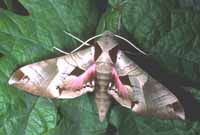 |
This moth should be present wherever grapes are found.
Fight would be from June to August. Larvae feed on grape foliage. |
Eumorpha achemon, Roseville, May 27, 2018, Ken Salvo
Macroglossini Tribe:
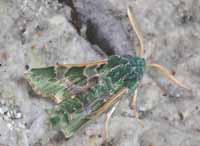 |
Arctonotus lucidus
WO, the Pacific Green
Sphinx Moth or Bear SphinxThis species is confirmed in nearby Butte
County by Patience Hervey, December 29-30, 2005.
It tends to be
an early winter-early spring flier, on the wing in the early evening. It comes to lights at night. |
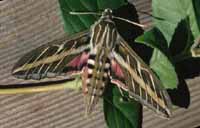 |
Hyles lineata
USGS,
the White-lined Sphinx
Adults usually fly at dusk, during the night, at dawn, and during the
day. Moths nectar at salvia and oviposit on Epilobium cana
(California fuchsia) and Hooker's Evening Primrose. |
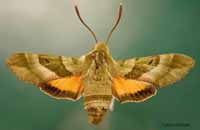 |
Adults fly in the afternoon from April-June in oak woodland and
pine-oak woodland in foothills, nectaring from chia, heartleaf
milkweed, golden currant, bluedicks, fairyfans, vetches,
thistles, hedgenettles, etc. |
|
|
Enjoy some of nature's wonderments, giant silk moth cocoons.
These cocoons are for sale winter and fall. Beautiful Saturniidae moths will emerge the following spring and summer.
Read Actias luna rearing article. Additional online help available.
Use your browser "Back" button to return to the previous page.
This page is brought to you by Bill Oehlke and the
WLSS. Pages are on space rented from Bizland. If you would like to become a
"Patron of the Sphingidae/Catocala Sites", contact Bill.
Please send sightings/images to Bill. I will do my best to respond to requests for identification help.
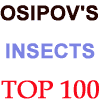 | 
Show appreciation for this site by clicking on flashing butterfly to the left.
The link will take you to a page with links to many insect sites. |







